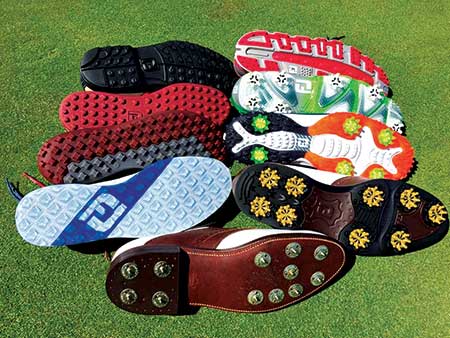Effect of golf shoe designs on putting greens

Depending on the model, some golf shoes cause more damage to putting greens than others. (Photo: Cole Thompson, Ph.D.)
Foot traffic can reduce putting green smoothness, especially when golf shoes had metal spikes. The damage has decreased as plastic cleats or spikeless golf shoes became the norm. There are concerns that new golf shoe designs may cause similar damage as metal spikes.
Thomas Nikolai, Ph.D., Michigan State University, and Doug Karcher, Ph.D., University of Arkansas, evaluated more than 20 golf shoe designs over two years on putting greens in Michigan, Arkansas, Florida and Scotland. They classified and compared today’s shoe designs with older soles, cleats and metal spikes. They evaluated spikeless shoes, shoes with plastic cleats and shoes with metal spikes. The shoes had outsoles made of rubber, polyurethane, thermoplastic polyurethane or thermoplastic elastomer. The experiments simulated 30 rounds of golf with each shoe design on creeping bentgrass, annual bluegrass, fine fescue, ultradwarf bermudagrass and seashore paspalum.
Foot traffic generally reduced the visual appearance of surface smoothness compared to control plots with no traffic. In some cases, golfers could not visually distinguish differences among control plots and noncontrol plots. Flat outsoles with cleat or spike inserts disrupted surface smoothness more than studded outsoles with cleat inserts. Studs increase the number of pressure points and may help disperse traffic by reducing the pounds per square inch each cleat transfers to a putting surface. Traffic from metal spikes was more visible than the most abrasive outsole materials and cleats currently on the market. Spikeless or cleated shoes caused more visible traffic as the number of studs, cleats or cleat prongs decreased. Spikeless, rubber outsoles generally caused less visible traffic than spikeless, thermoplastic polyurethane outsoles.
Cleated designs caused more visible traffic than spikeless models. Cleated, thermoplastic polyurethane outsoles caused less visible traffic than cleated outsoles with a combination of polyurethane and thermoplastic polyurethane. Cleated, thermoplastic elastomer outsoles caused the most visible traffic.
This project was funded in part by the USGA Green Section.










